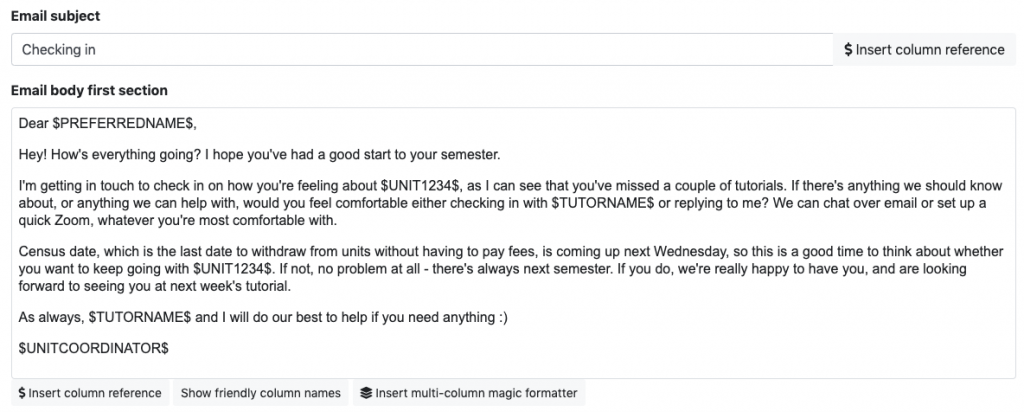Since the end of the free tertiary education reforms introduced by the Whitlam government, most domestic students have seen their time at university supported by Higher Education Loan Program (HELP) funding. This program offsets the payment of tuition fees for eligible students until they are able to pay it off through their taxable earnings. Participation rates have risen to the extent that, as of 2019, over 40% of 19-year-olds are taking part in higher education [1]. Before now there have been few limits to HELP funding beyond eligibility, but from the 1 January 2022, new students will need to maintain at least a 50% pass rate to retain their access to the scheme [2][3].
Why does this matter?
Students who drop below a 50% pass rate after taking at least eight units will need to pay full unit fees up front until their average returns to a pass or higher [4]. It seems reasonable to anticipate that students will be less likely to return to their studies when this means facing a financial penalty. Financial pressure is one of the leading reasons cited by low-SES, regional and remote, and Indigenous students for feeling forced to drop out of University [5] so these changes will likely affect them to an even greater extent. University-wide programs will be developed through 2021 to support our students, but unit coordinators and teachers also have an important role to play.
Here’s an example: a new student offered a Commonwealth Supported Place in the Bachelor of Arts will defer $14,500 per year to HECS-HELP (per 2021 fee structures). Under the new rules, if this student fails five of eight enrolled units in their first year of study, they are deemed to be below the pass rate and thus will have to pay $7,250 upfront to re-enrol full-time for the first semester of their second year. In the first semester of their second year, the student will then need to pass all four units to re-gain HELP access. If they don’t, they’ll have to continue to pay upfront until they achieve the pass threshold.
Simply put, we need to be able to identify students who are at risk of losing access to HELP funding before they actually do. This will look different for each unit of study, so teachers and unit coordinators have a critical role to play. Providing early feedback and checking in with students on key course engagement and attrition markers are two relatively easy ways to do this, and require only very small (if any) changes to existing unit outlines or plans. Such actions will also be appreciated by all students. Changes to assessments may require proposal and approval 12 months or more in advance, and check-in strategies may also take a little time to design and finesse, especially for large first-year classes, so it’s worth thinking about these things now. Trying things out now in 2021 before they become essential in 2022 also allows for reflection and feedback, and this year’s students will certainly benefit as well.
Supporting students with early feedback
An early assessment returned with meaningful feedback is one of the most tangible and impactful ways for students and teachers to gauge progress. Assessments of this type are already in place for many units of study, one of the most common being a diagnostic test delivered in units with assumed knowledge requirements. Ideally every student will receive feedback on a meaningful task before census date [6] (usually week five in semester one and two), but in-classroom tasks with feedback can also be used. Updates to the 2021 assessment framework strongly recommend that all units include a pre-census assessment, though only mandate it at the 1000- and 5000-level where they have shown efficacy as a support mechanism for first-year student transition [7]. These assessments can be useful beyond being an early indicator of content comprehension; feedback can identify general skills in which students may require extra support, and offer referrals for faculty- or University-wide initiatives.
In choosing the assessment and its weighting, it is important to balance the need for the task to be meaningful without adding too much workload pressure and stress for the students. The task also needs to be a guide for the teacher as a measure of progress and likely success. Finally, in order to signal that students should prioritise it, this assessment must be strongly aligned with unit learning outcomes. Unit coordinators and teachers will instinctively know the key indicators for success from previous years and can build tasks around these.
Often the easiest way to design an early summative assessment is to use it as a check-in for a larger assessment due later in semester. These incentivise starting early (or rather, at the appropriate time as it relates to unit content), and provide students with a measure of their progress towards the more heavily-weighted task. Guidelines for the best-practice use of these assessments include writing clear instructions, ensuring consistent expectations, and building in feedback comprehension sessions [8].
Here are just a few ideas for low-stakes pre-census summative assessments:
- Quiz testing foundational skills or knowledge
- A collection of pre-lecture quiz results, as part of a flipped class format
- Annotated bibliography
- Draft structure or outline for larger assessment
- Discussion board posts
- Skill demonstration
- Weekly reflective journal
For units with ongoing mandatory or experiential activities, including laboratory work, assessments related to active engagement can also be considered. At the simplest level, this might include active participation or completion of preparation tasks, such as pre-laboratory or safety quizzes.
If extra summative assessments can’t be added, in-classroom tasks with integrated feedback are another option. We strongly advise that unweighted tasks designed to give a formal indicator of progress only take place in timetabled, preferably synchronous (live online or live face-to-face), sessions. Ideally these would run over multiple weeks at the start of semester to capture sustained engagement. Poor time management is rarely a reason why students miss extra set classwork; it is much more likely that substantial paid work, caring, or other critical responsibilities are prioritised to support students’ attendance at timetabled classes [9].
Here are just a few ideas for adaptable in-class tasks for which feedback can be easily delivered:
- Tutorials set aside for working on assessment drafts or outlines with tutor support
- Pop quizzes followed by tutor-led answer review
- Peer review after the completion of tutorial worksheets
- Minute papers (written either in groups or individually) with immediate or next-week review
Promoting early engagement
Think about the first few things we recommend students do when our units start each semester; checking out the Canvas site and the unit outline would be at the top of any unit coordinator’s list. Regularly accessing Canvas in particular is a behavioural bellwether, as students who do not do this early are less likely to successfully continue in the unit. Following up with students who do not meet expected behavioural benchmarks has a proven record of success at Sydney. Fostering engagement can begin as early as Welcome Week, and can be used alongside the assessment redesign proposal outlined above. The Student Relationship and Engagement System (SRES) was developed in-house with just this situation in mind, and we’ll be running plenty of introductory workshops this year.
Context is incredibly important when developing an engagement strategy – checking work placement schedules may be incredibly important for some units and irrelevant for others, just as the importance of lecture attendance may vary. When designing yours, you could list all aspects of the unit (assessments, lectures, tutorials, readings, pre-work or post-work, etc.) in order of importance, and prioritise encouraging engagement with just the top few to avoid check-in fatigue.
Here are a few ideas:
- Week 0: A personalised welcome message thanking students for checking out the unit’s Canvas site or a particular page, or encouraging them to do so.
- Week 0: Check out the Knowing Your Students report for your unit. This includes details of the most commonly units that your students are enrolled in, enabling you to see what other assessments they will be taking from the relevant unit outlines.
- Week 1: Introducing students to their tutors and reminding them of their room number or Zoom link.
- Weeks 1-4 and onwards: Capturing relevant information from the teaching team on student engagement and progress (e.g. class participation; students who seem to be struggling; attendance records)
- Weeks 3 or 4: Checking in on students who appear to not be meeting progress milestones (e.g. haven’t submitted their first assignment or scored less than 50%; or who have missed two or more tutorials). Encouraging those who are tracking well.
- Week 4 or early week 5: Checking in students who have low stats in a combination of the above markers to remind them of census date, and offer your support.

A warm and welcoming but firm message the week before census date sent to those not yet meeting expected performance or engagement thresholds with an invitation to meet and chat will go a long way. This one was sent using SRES.
These supportive messages can be delivered by unit coordinators and/or other teaching staff in many different ways – emails or filters (in SRES) allow for personalisation, but announcements through Canvas or in-person (or live on Zoom) can also work. Keep an eye on what happens afterwards – we’ve seen absent fail numbers go down significantly after engagement is actively tracked and supported.
Want to learn more?
- Book a consult with an educational designer to discuss any of the above solutions
- Attend an SRES workshop and keep any eye on other workshops on offer throughout the year.
Notes and references
[1] Department of Education, Skills and Employment: Higher Education Statistics
[2] Department of Education, Skills and Employment: Job-ready Graduates Package
[3] Schedule 4, Failure to complete previous units, of the Higher Education Support Amendment (Job-ready Graduates and Supporting Regional and Remote Students) Bill 2020
[4] As of January 2021 these rules specifically state 50% of attempted units, rather than 50% of attempted credit points. It is possible that this will change. Not all units at Sydney are worth 6 credit points, notably many MATH1 (3 cp) and OLE (2 cp) units. The rules also currently state that pass rates do not follow students who change degrees or institutions.
[5] Harvey A et al 2017, The re-recruitment of students who have withdrawn from Australian higher education, La Trobe University.
[6] Census date is the date when students’ enrolment in a unit are finalised and they become academically and financially liable. Each semester and intensive session has a distinct census date and is commonly 4 or 5 weeks after teaching starts. With greater use of intensive periods for units, such as those in the Open Learning Environment, it is worth making sure that students are aware of the date for your unit such as by including it in the Canvas course calendar.
[7] Kift S et al 2009, Articulating a transition pedagogy to scaffold and to enhance the first year student learning experience in Australian higher education, Queensland University of Technology
[8] Thomas T et al 2019, Students’ perspectives of early assessment tasks in their first-year at university, Assessment & Evaluation in Higher Education, 44(3)
[9] Burke, P J et al 2017, It’s about time: working towards more equitable understandings of the impact of time for students in higher education, University of Newcastle






2 Comments